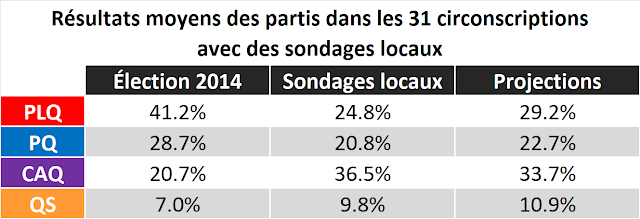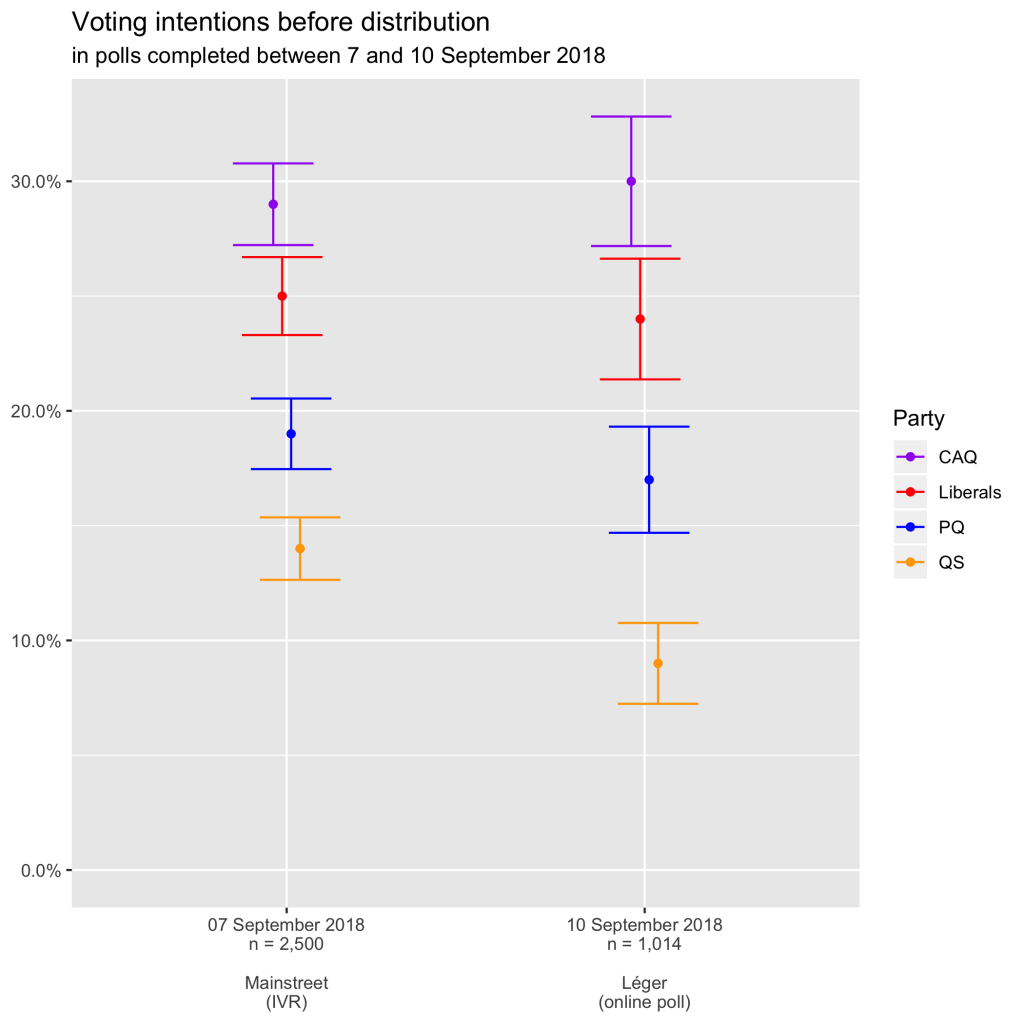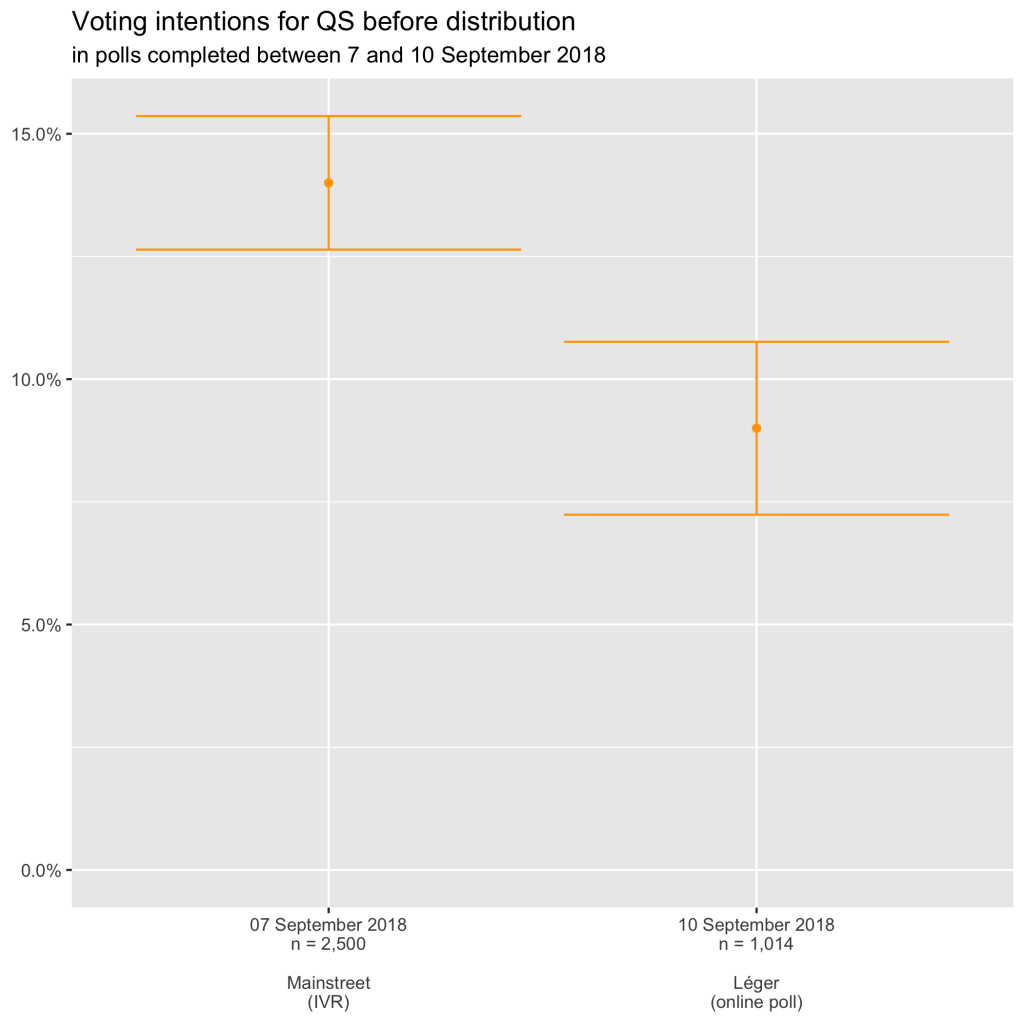In “#Not all small parties,” I had asked whether Citoyens au pouvoir was a party to watch, despite being relatively new and passed over by pollsters. When checking the number of official candidates yesterday, I came to the conclusion that it indeed was: it has more authenticated candidates than both the NDP Québec and the Marxist-Leninist Party.
Here’s the current state of the parties involved, according to the initial classification.
|
Nb of candidates |
Contributions |
Voting intentions |
| Parties with seats at the National Assembly |
| Coalition avenir Québec |
117 |
$594,268 |
34.0% |
| Liberals |
98 |
$716,890 |
30.4% |
| Parti québécois |
93 |
$997,622 |
19.6% |
| Quebec Solidaire |
78 |
$436,110 |
12.4% |
| Parties to watch |
| Green Party of Quebec |
43 |
$10,679 |
1.9% |
| Conservative Party of Québec |
50 |
$22,986 |
1.1% |
| NDP Quebec |
15 |
$31,200 |
0.7% |
| Fixtures of recent Quebec elections |
| Marxist-Leninist Party of Quebec |
19 |
$6,055 |
| Bloc Pot |
3 |
$6,149 |
| New kids on the block |
| Citoyens au pouvoir du Québec |
21 |
$12,241 |
| Équipe autonomiste |
5 |
$500 |
| Parti nul |
3 |
|
| Party 51 |
1 |
$931 |
| Parti libre |
1 |
$650 |
| Alliance provinciale du Québec |
1 |
|
| Québec en marche |
|
$275 |
| Cosmopolitan Québec |
|
$100 |
| Parti équitable |
|
$5 |
See how Citoyens au pouvoir outweigh the two fixtures of recent elections in both fundraising and number of candidates? In addition to its 21 official candidates, Citoyens au pouvoir has announced 45 others on its website. We still need to see, however, if all these aspiring candidates will manage to collect this week the 100 signatures from voters in their riding they need.
Still, I’ve officially moved Citoyens au pouvoir into the “Parties to watch” category.
What is this Citoyens au pouvoir party?
The parties that the pollsters are already watching all have federal-level equivalents (the Green Party, the Conservative Party, and the NDP). Therefore, even if the provincial press does not cover them in this campaign, people who follow politics will have a general sense of where these parties stand ideologically.
It’s thus seems even more important for the provincial press to minimally introduce Citoyens au pouvoir since we have no referent to know what it stands for.
So I did a bit of Googling and came up with this press review.
Press interviews with five candidates
I found five mainstream media articles introducing candidates:
- Denis Paré in Deux-Montagnes;
- Jacques Gosselin in Laviolette-Saint-Maurice;
- Jean-François Racine in Marguerite-Bourgeoys (which covers LaSalle, Montreal);
- Manon Gamache in Brome-Missisquoi;
- Nicole Goulet in Beauce-Nord.
Among these, only Denis Paré and Nicole Goulet had filed their candidacy with the Chief Electoral Officer on Monday morning. Repeating an argument previously used by Quebec Solidaire, she explains: “On ne divise pas le vote, on offre une différence. Notre clientèle cible, ce sont les 1 700 000 abstentions qui ne trouvent pas leur compte.”
In an early September interview, Manon Gamache, the party’s deputy managing director, thought they might be able to run more than 60 candidates, “un bond de géant depuis la dernière élection.” When Denis Paré was announced as a candidate in July, party leader Stéphane Blais said he was aiming for 125 candidates and between 6.5% and 7% of the vote share province-wide, on par with the late Action démocratique du Québec when it was created.
Jacques Gosselin is vice-president of the Bloc Québécois’s executive board in the Mauricie region. Jean-François Racine had submitted his candidacy to represent the Coalition Avenir Québec. (The CAQ chose to run Vicky Michaud instead.)
An Islamophobic candidate had to step aside
On 19 June, the gossipy yet political section of the tabloid Journal de Québec showed screenshots of Michel A. Fournier’s Facebook wall. He was the Citoyens au pouvoir’s candidate for Matane-Matapédia. In her summary, journalist Marie-Renée Grondin wrote that he believed that “we must kill islamism” before “it kills us” and that a referendum should be held to “suppress” all mosques throughout Quebec.
On 3 August, the regional paper, Rimouski’s L’Avantage, reported that this Islamophobic candidate had stepped aside. According to the party’s website, he has been replaced by Jacques Langlois, but the party’s Facebook page for Matane-Matapédia still says that it’s searching for a candidate.
At first, there was the constituent assembly
I found the clearest explanation for the party’s successive name changes in a blog post by Xavier Camus:
À l’origine (2011-2012), la formation politique – cofondée par Roméo Bouchard – se nommait «La Coalition pour la Constituante», car on y préconisait une refonte totale du politique, par le biais d’une assemblée constituante. Puisqu’on y prêche aussi l’abandon de la notion de partis politiques et de la partisanerie sans fin, la formation prendra le nom de «Parti des sans parti» de 2013 à 2016, pour devenir [Citoyens au pouvoir] sous Rambo Gauthier.
In January 2017, Frank Malenfant, co-spokesperson for Citoyens au pouvoir, left the party. In his farewell Facebook message, he explains:
Les nouveaux arrivants aussi ont droit à la dignité et aux meilleures chances d’intégration possible pour devenir des membres productifs de notre société. Je me dissocie publiquement de tous propos allant à l’encontre de ces valeurs que je me suis promis de servir pour le parti, et qui sont aussi fondamentalement les miennes.
He joined Option nationale over the course of the year and followed his new party as it merged with Quebec Solidaire.
Exit Rambo, enter Stéphane Blais
In December 2017, the remaining spokesperson, (in)famous trade unionist Bernard “Rambo” Gauthier, left the party to concentrate on his health. (As a partisan politics retiree myself, I believe him and command him for having owned his limits.)
The next month, the party had found a new leader (note the change in vocabulary):
Janvier 2018, nomination de l’activiste et homme d’affaires Stéphane Blais, CPA, VP du mouvement intégrité Québec, à titre de chef par intérim du parti. Sous sa gouverne, le parti prévoit présenter 125 candidats aux élections à l’automne 2018 et solidifier ses finances en vue d’augmenter sa visibilité auprès du grand public.
In July, Stéphane Blais was a guest on FM93 radio, whose hosts include Éric Duhaime and Doc Mailloux. According to the write-up in Le Peuple newspaper, he explained that his party:
compte faire élire des «non-professionnels» de la politique et vise à prendre le pouvoir le temps d’un seul et unique mandat. L’idée centrale demeurant, depuis sa fondation jusqu’à nos jours, de permettre au peuple québécois de court-circuiter la machine électorale le temps de faire un grand ménage en ce qui concerne la gestion du bien commun.
Far-right media
Le Peuple is put together by four men, all bearing the title of “writer and fact-checker.” Pascal Bergeron, founder and current president of the newspaper, also writes Islamophobic and transphobic articles on Vigile.quebec.
Le Peuple’s articles are reprinted on the website of Horizon Québec Actuel, a non-profit that aims for “la diffusion de la langue française, le réseautage entre pays francophones et la défense du principe de souveraineté des États-Nations.” In April 2017, the organization endorsed Marine Le Pen, the far-right French presidential candidate, on its channel Nomos-TV.
The organization’s Facebook page has since been removed by the social media giant. This new development seems recent because, in the middle of August, Patrice-Hans Perrier published an article on Le Peuple claiming the “guillotine of censorship” had landed on the heads of “patriots.” The article was shared on the Horizon Québec Actuel website under a new title.
Xavier Camus raises the issue of more direct links between Citoyens au pouvoir and the far right in two blog posts published a year apart. The first was published when the party was led by spokesperson Bernard “Rambo” Gauthier. The second reports on the regime change that saw Yvon Simard’s pack ousted by Stéphane Blais’s crew.
A mixed bag
Citoyens au pouvoir is therefore a party to watch in many different ways. The leader of its forebearer, the “Party of the party-less,” is now with Quebec Solidaire. Some candidates come from the CAQ or the Bloc Québécois. From the pictures of candidates on the party’s website, we can tell that there’s at least one racialized candidate: Jean Carrière in Mirabel, who is not an official candidate yet though.
So the party is actually a mixed bag, bringing together a variety of people promoting direct democracy on which you’ll want to keep an eye!


